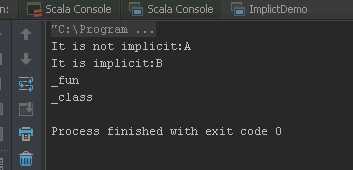标签:
Scala中implict的一种用法就是扩展现有类的方法,有点类似于.Net中的扩展方法(MS对扩展方法的介绍:扩展方法使你能够向现有类型“添加”方法,而无需创建新的派生类型、重新编译或以其他方式修改原始类型。)
Scala中有两种方式做到方法的扩展,以扩展String为列:
第一种(code:10-12,29):创建一个以implict修饰的新类并以String类型入参。在新的类型(代码中是mystring)中添加要扩展的方法(read2)
第二种(code:3-5,9,28): 创建一个以implict修饰的方法并以String类型入参,方法中创建一个对象(代码中是RichString),该对象中包含要扩展的方法(read)
Implict另一种用法是定义一个隐含的方法参数:code27行只传入一个参数,方法的另一个参数则取之code 8行。这种用发的前提是方法的参数必须有用implict修饰(code 17),才可以使用使用前面定义的隐含参数(code 8)
代码和运行结果如下:
1 object ImplictDemo { 2 3 class RichString(val s:String){ 4 def read = (s + "_fun").mkString 5 } 6 7 object Context{ 8 implicit val impStr:String = "It is implicit" 9 implicit def fun(s:String) = new RichString(s) 10 implicit class myString(val s:String){ 11 def read2 = (s + "_class").mkString 12 } 13 } 14 15 16 object Param{ 17 def print(content:String)(implicit prefix:String){ 18 println(prefix+":"+content) 19 } 20 } 21 22 def main(args: Array[String]) { 23 Param.print("A")("It is not implicit") 24 25 import Context._ 26 import Context.fun 27 Param.print("B") 28 println(new String("").read) 29 println(new String("").read2) 30 } 31 32 }

标签:
原文地址:http://www.cnblogs.com/1zhk/p/4736356.html